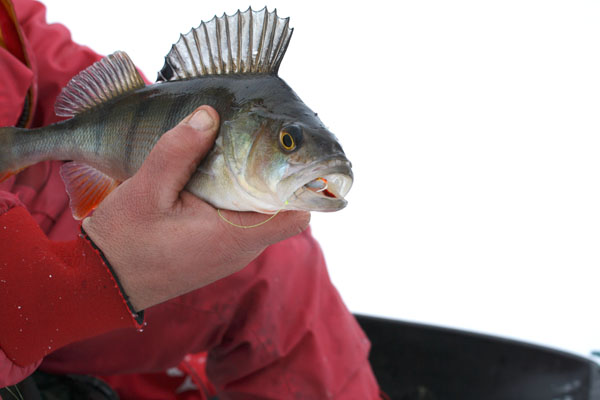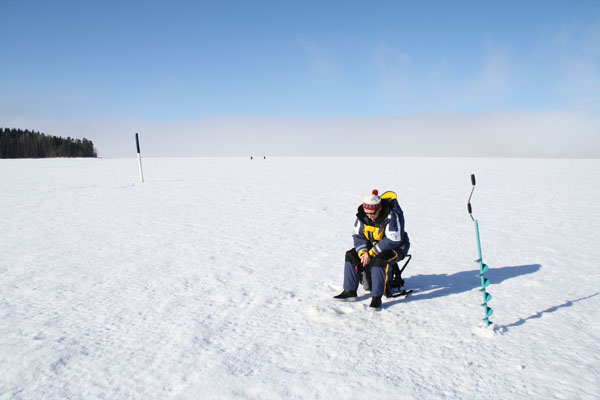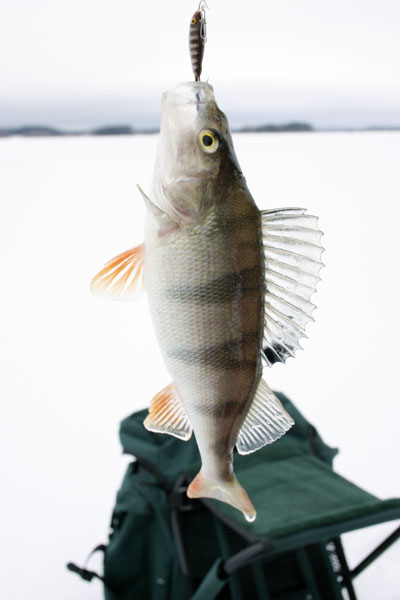|
ZANDERLAND - Winter fishing - The biggest fish bite balanced jigging lures |
|
|
 |
||
|
Lake Pyhäjärvi |
||
| Video Mallasvesi | ||
| The biggest fish bite balanced jigging lures |
|
ZANDERLAND - Winter fishing - The biggest fish bite balanced jigging lures |
|
|
 |
||
|
Lake Pyhäjärvi |
||
| Video Mallasvesi | ||
| The biggest fish bite balanced jigging lures |
| In the winter, people go after perch with ice-fishing tackle. Real whoppers can be caught using vertical jigging lures and mormyshka jigs. A balanced jigging lure is the most powerful weapon when pursuing the biggest stripers. |
|
|
|
Lake Rautavesi |
| Tampere resident Jouko Rontu
has enjoyed fishing perch with balanced jigging lures for 40 years. In
February 2005, his self-made balanced jigging lure was snatched on Lake
Kukkia by a 2.475-kilo whopper, which was the record 21st century catch for
rod tackle in Finland at the time. Jouko relates that ice-fishing lures
caught plenty of big perch that winter. The ten largest perch caught on a
single fishing trip weighed more than 11 kilos in total. Another, 1.9-kilo
whopper perch struck a balanced jigging lure in the same area three days
after the record fish. Thanks to the warm summers, big perch have become increasingly common in lakes since the turn of the new millennium. Jouko explains that seagull attacks and hunting perch, which disappeared in many places during the 1980’s, have gradually started to occur again in autumn. |
|
|
| A thick line on a special jigging stick |
| On a jigging stick
specifically used with balanced jigging lures, the line is coiled around
metal-wire forks. The lightweight sticks made by Jouko have a handle made
from abachi or balsa wood and they make it easy to swim a balanced jigging
lure. The monofilament line is at least 0.26 mm thick. Jouko starts swimming a balanced jigging lure at 6 or 7 turns of the stick, or at about 4 metres from the bottom. The lure is floated constantly varying the force and scope of tugs. You can also flutter the lure slightly. You should fish the column of water all the way down, sweeping the bottom once in a while, and then start to raise the lure upwards again. Sometimes, big perch can be found right below the ice. However, it is the layer of water a few metres upwards from the bottom that is generally where the fish will bite. Big perch seldom bite straight away, so it’s worth fishing for quite a long time in one hole. Once you have hauled the first fish up, lower the lure back to the same depth. You should be able to hook a big perch in one go, because the hole may die down immediately if the fish escapes or gets hit on its jaws badly. |
 |
| When a big perch is ready to bite, it strikes a balanced jigging lure with a vengeance. |
| The action starts in February |
| You can go after big perch
throughout the winter. You may sometimes get good catches on fresh ice.
Midwinter is often a slower time, until the best season for balanced jigging
lures really starts in February. The record fish was deceived by a balanced
jigging lure on 14th February. The
daylight period is still not very long in February and big perch feed during
daytime. The hours before noon are the best times, but some biting spurts
may also occur in the afternoons. Towards the onset of spring, the best
feeding time focuses more and more clearly on sunrise and sunset. |
 |
| Balanced jigging lures are at
their most effective in February and March, when the ice is still covered in snow. Lake Näsijärvi. |
| Tips for finding whoppers |
| - Big perch are not found everywhere, so choose a lake where they can be found. |
| - The potential season for balanced jigging lures stretches from February through to mid-March, while mormyshka jigs become more effective later in the spring. |
| - Spots worth trying include banks of mid-lake shoals and plateaus in the midst of deep water at 5 to 8 metres. |
| - Natural holes and cracks in the ice and snowless dark areas amidst snow-covered ice are spots that you shouldn’t pass by without having a go. |
| - When you finally find a hot spot for big perch, you should try fishing in the same spot again over the next few weeks. |
 |